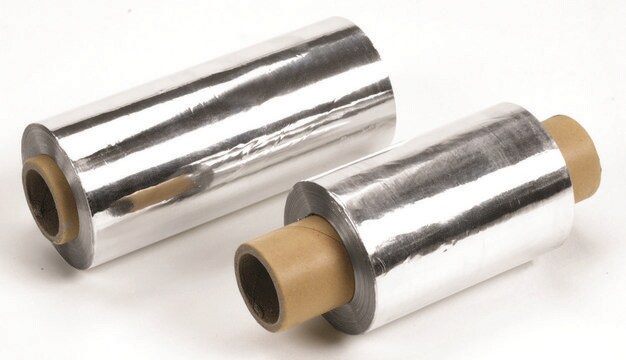266574
Aluminum
foil, thickness 0.45-0.55 mm, 99.999% trace metals basis
About This Item
Produtos recomendados
Agency
suitable for EPA OTM-45
Nível de qualidade
Ensaio
99.999% trace metals basis
forma
foil
temperatura de autoignição
1400 °F
resistividade
2.6548 μΩ-cm
espessura
0.45-0.55 mm
pb
2460 °C (lit.)
pf
660.37 °C (lit.)
densidade
2.7 g/mL at 25 °C (lit.)
aplicação(ões)
battery manufacturing
cadeia de caracteres SMILES
[Al]
InChI
1S/Al
chave InChI
XAGFODPZIPBFFR-UHFFFAOYSA-N
Categorias relacionadas
Quantidade
- 50×50 mm (approximately 3.4 g)
- 100×100 mm (approximately 13.6 g)
Código de classe de armazenamento
11 - Combustible Solids
Classe de risco de água (WGK)
WGK 3
Ponto de fulgor (°F)
Not applicable
Ponto de fulgor (°C)
Not applicable
Equipamento de proteção individual
Eyeshields, Gloves, type N95 (US)
Certificados de análise (COA)
Busque Certificados de análise (COA) digitando o Número do Lote do produto. Os números de lote e remessa podem ser encontrados no rótulo de um produto após a palavra “Lot” ou “Batch”.
Já possui este produto?
Encontre a documentação dos produtos que você adquiriu recentemente na biblioteca de documentos.
Os clientes também visualizaram
Artigos
In many technologies, performance requirements drive device dimensions below the scale of electron mean free paths (λe). This trend has increased scientific interest and technological importance of electrical resistivities at the nanoscale.
Can there be an effective strategy for finding breakthrough materials, since they are, by definition, unpredictable? One answer is found in Combinatorial Materials Science techniques, which represent a powerful approach to identifying new and unexpected materials.
The unique properties of the rare-earth elements and their alloys have brought them from relative obscurity to high profile use in common hightech applications.
Biomedical implants are essentially foreign substances within the human body that must survive many years’ exposure to demanding mechanical and physiological conditions. Despite these challenges, metal implants have been widely used to substitute for or rebuild hard tissues such as bones and teeth.
Nossa equipe de cientistas tem experiência em todas as áreas de pesquisa, incluindo Life Sciences, ciência de materiais, síntese química, cromatografia, química analítica e muitas outras.
Entre em contato com a assistência técnica


